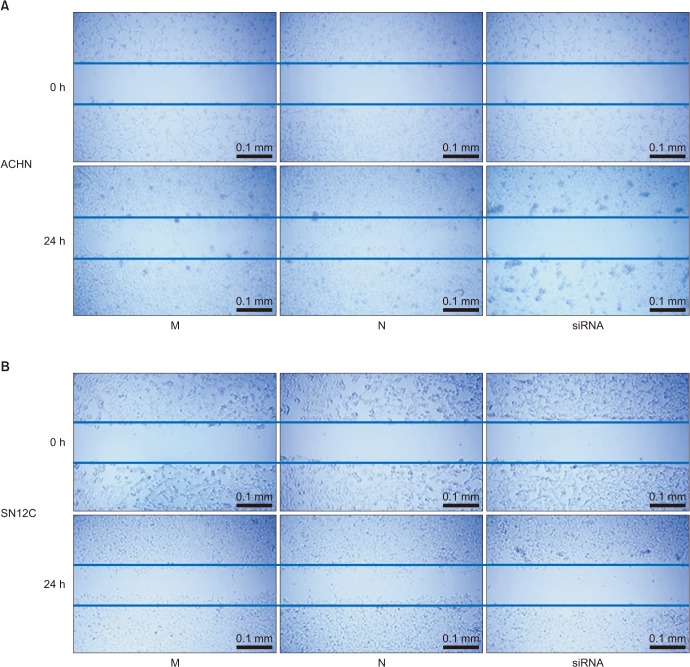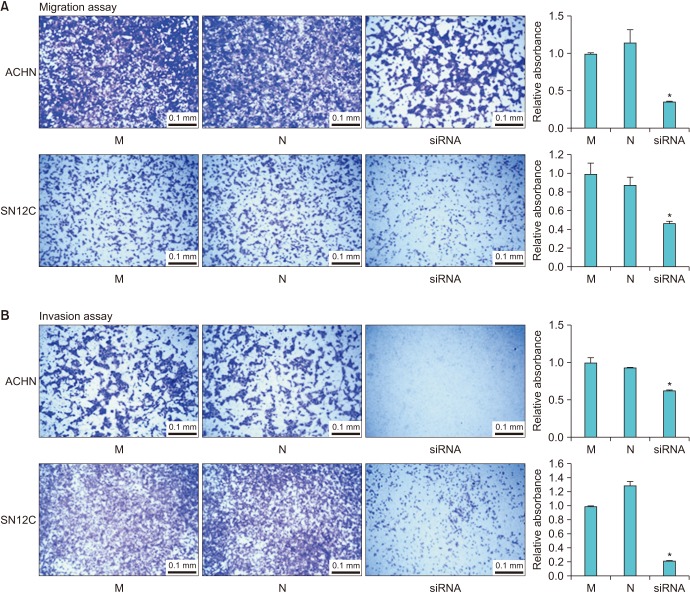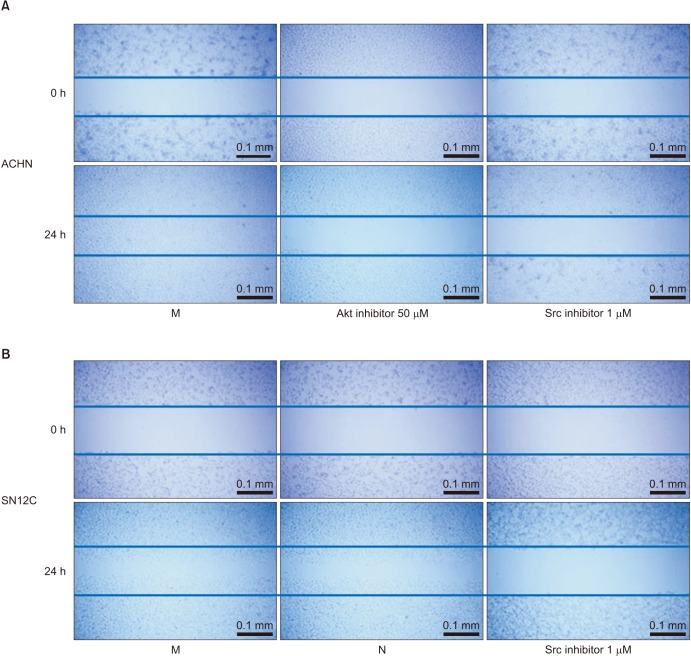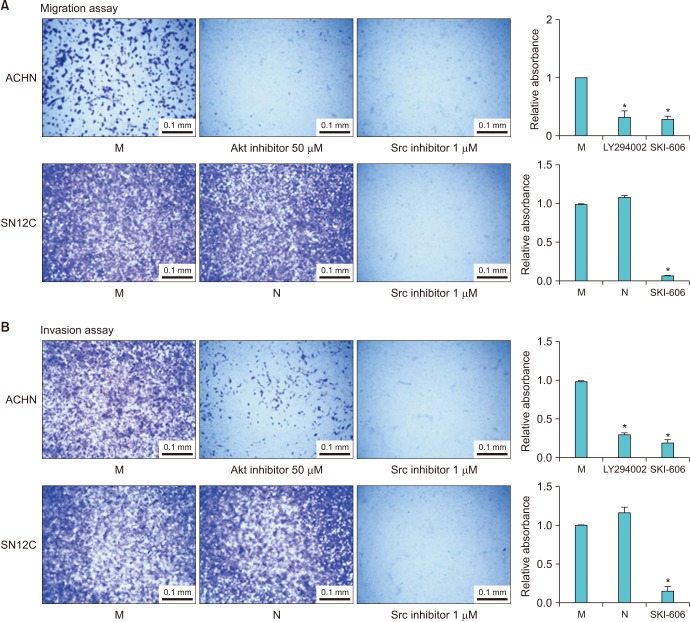1. Siegel RL, Miller KD, Jemal A. Cancer statistics, 2017. CA Cancer J Clin. 2017; 67:7–30. PMID:
28055103.

2. Compérat E, Camparo P. Histological classification of malignant renal tumours at a time of major diagnostic and therapeutic changes. Diagn Interv Imaging. 2012; 93:221–231. PMID:
22465787.

3. Athar U, Gentile TC. Treatment options for metastatic renal cell carcinoma: a review. Can J Urol. 2008; 15:3954–3966. PMID:
18405442.
4. Cohen HT, McGovern FJ. Renal-cell carcinoma. N Engl J Med. 2005; 353:2477–2490. PMID:
16339096.

5. Choi JY, Ko YH, Song PH. Clinical significance of preoperative thrombocytosis in patients who underwent radical nephrectomy for nonmetastatic renal cell carcinoma. Investig Clin Urol. 2016; 57:324–329.

6. Duensing S, Hohenfellner M. Adjuvant therapy for renal-cell carcinoma: settled for now. Lancet. 2016; 387:1973–1974. PMID:
26969091.

7. Gaudet R. A primer on ankyrin repeat function in TRP channels and beyond. Mol Biosyst. 2008; 4:372–379. PMID:
18414734.

8. Lehen'kyi V, Shapovalov G, Skryma R, Prevarskaya N. Ion channnels and transporters in cancer 5 Ion channels in control of cancer and cell apoptosis. Am J Physiol Cell Physiol. 2011; 301:C1281–C1289. PMID:
21940667.
9. Runnels LW, Yue L, Clapham DE. TRP-PLIK, a bifunctional protein with kinase and ion channel activities. Science. 2001; 291:1043–1047. PMID:
11161216.

10. Ryazanova LV, Rondon LJ, Zierler S, Hu Z, Galli J, Yamaguchi TP, et al. TRPM7 is essential for Mg
2+ homeostasis in mammals. Nat Commun. 2010; 1:109. PMID:
21045827.
11. Latorre R, Zaelzer C, Brauchi S. Structure-functional intimacies of transient receptor potential channels. Q Rev Biophys. 2009; 42:201–246. PMID:
20025796.

12. Kunzelmann K. Ion channels and cancer. J Membr Biol. 2005; 205:159–173. PMID:
16362504.

13. Reis ST, Leite KR, Piovesan LF, Pontes-Junior J, Viana NI, Abe DK, et al. Increased expression of MMP-9 and IL-8 are correlated with poor prognosis of bladder cancer. BMC Urol. 2012; 12:18. PMID:
22695075.

14. Jung KW, Won YJ, Oh CM, Kong HJ, Lee DH, Lee KH. Prediction of cancer incidence and mortality in Korea, 2017. Cancer Res Treat. 2017; 49:306–312. PMID:
28301926.

15. Lee JN, Chun SY, Lee HJ, Ha YS, Kim HT, Yoo ES, et al. High Notch1 expression correlates with tumor stage and size in clear cell renal cell carcinoma. Korean J Urol Oncol. 2016; 14:130–137.

16. Wang J, Zhao X, Qi J, Yang C, Cheng H, Ren Y, et al. Eight proteins play critical roles in RCC with bone metastasis via mitochondrial dysfunction. Clin Exp Metastasis. 2015; 32:605–622. PMID:
26115722.

17. Cho YH, Kim MS, Chung HS, Hwang EC. Novel immunotherapy in metastatic renal cell carcinoma. Investig Clin Urol. 2017; 58:220–227.

18. Gupta GP, Massagué J. Cancer metastasis: building a framework. Cell. 2006; 127:679–695. PMID:
17110329.

19. Meng X, Cai C, Wu J, Cai S, Ye C, Chen H, et al. TRPM7 mediates breast cancer cell migration and invasion through the MAPK pathway. Cancer Lett. 2013; 333:96–102. PMID:
23353055.

20. Gao H, Chen X, Du X, Guan B, Liu Y, Zhang H. EGF enhances the migration of cancer cells by up-regulation of TRPM7. Cell Calcium. 2011; 50:559–568. PMID:
21978419.

21. Callera GE, He Y, Yogi A, Montezano AC, Paravicini T, Yao G, et al. Regulation of the novel Mg
2+ transporter transient receptor potential melastatin 7 (TRPM7) cation channel by bradykinin in vascular smooth muscle cells. J Hypertens. 2009; 27:155–166. PMID:
19145781.
22. Song G, Ouyang G, Bao S. The activation of Akt/PKB signaling pathway and cell survival. J Cell Mol Med. 2005; 9:59–71. PMID:
15784165.

23. Guo H, German P, Bai S, Barnes S, Guo W, Qi X, et al. The PI3K/AKT pathway and renal cell carcinoma. J Genet Genomics. 2015; 42:343–353. PMID:
26233890.

24. Duran I, Lambea J, Maroto P, González-Larriba JL, Flores L, Granados-Principal S, et al. Resistance to targeted therapies in renal cancer: the importance of changing the mechanism of action. Target Oncol. 2017; 12:19–35. PMID:
27844272.

25. Playford MP, Schaller MD. The interplay between Src and integrins in normal and tumor biology. Oncogene. 2004; 23:7928–7946. PMID:
15489911.

26. Reddy KB, Nabha SM, Atanaskova N. Role of MAP kinase in tumor progression and invasion. Cancer Metastasis Rev. 2003; 22:395–403. PMID:
12884914.
27. Roseweir AK, Qayyum T, Lim Z, Hammond R, MacDonald AI, Fraser S, et al. Nuclear expression of Lyn, a Src family kinase member, is associated with poor prognosis in renal cancer patients. BMC Cancer. 2016; 16:229. PMID:
26984511.

28. Li JK, Chen C, Liu JY, Shi JZ, Liu SP, Liu B, et al. Long noncoding RNA MRCCAT1 promotes metastasis of clear cell renal cell carcinoma via inhibiting NPR3 and activating p38-MAPK signaling. Mol Cancer. 2017; 16:111. PMID:
28659173.

29. Lue HW, Cole B, Rao SA, Podolak J, Van Gaest A, King C, et al. Src and STAT3 inhibitors synergize to promote tumor inhibition in renal cell carcinoma. Oncotarget. 2015; 6:44675–44687. PMID:
26625308.

30. Yuan H, Meng X, Guo W, Cai P, Li W, Li Q, et al. Transmembrane-Bound IL-15-promoted epithelial-mesenchymal transition in renal cancer cells requires the Src-dependent Akt/GSK-3β/β-catenin pathway. Neoplasia. 2015; 17:410–420. PMID:
26025664.













 PDF
PDF ePub
ePub Citation
Citation Print
Print




 XML Download
XML Download